Project Report: Management Accounting Analysis of US Bright Production
VerifiedAdded on 2020/05/28
|13
|3464
|173
Project
AI Summary
This project report presents a detailed analysis of management accounting principles, focusing on costing systems and budgeting methods within a production company, specifically US Bright Production. The report is divided into two main parts: Part A explores activity-based costing (ABC), evaluating the cost per unit of cakes and preparing a bill of activities to determine product costs, including a specific analysis of Lamington products. The report calculates the cost per unit, considering various activities and cost drivers, and provides detailed calculations for the bill of activities. Part B delves into budgeting, examining the company's current and future cash inflows, and assessing the impact of changes in the fee structure. The report includes calculations and evaluations of the company's financial position, offering insights for decision-making in costing, pricing, and overall financial management. References to relevant literature support the analysis.
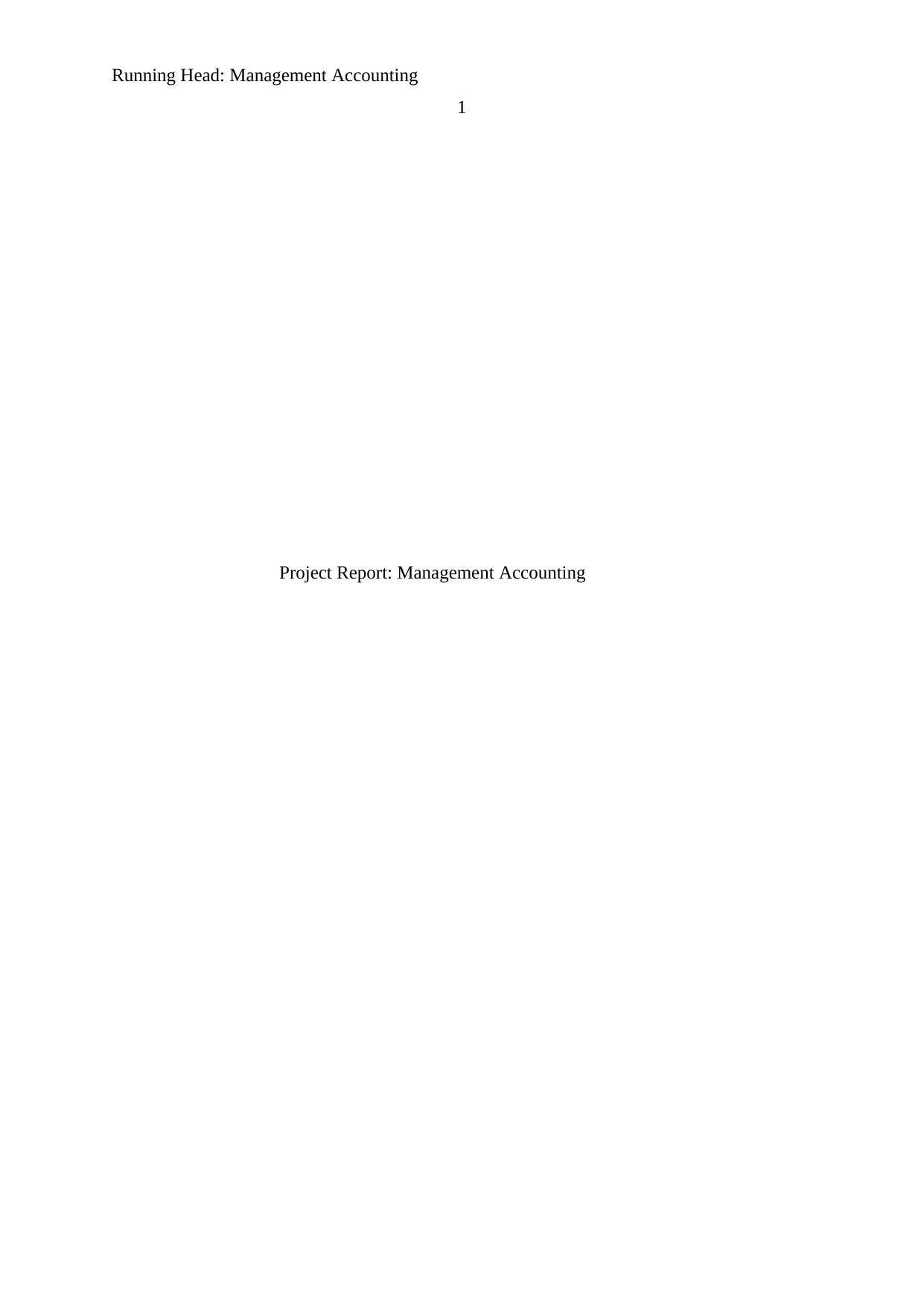
Running Head: Management Accounting
1
Project Report: Management Accounting
1
Project Report: Management Accounting
Paraphrase This Document
Need a fresh take? Get an instant paraphrase of this document with our AI Paraphraser
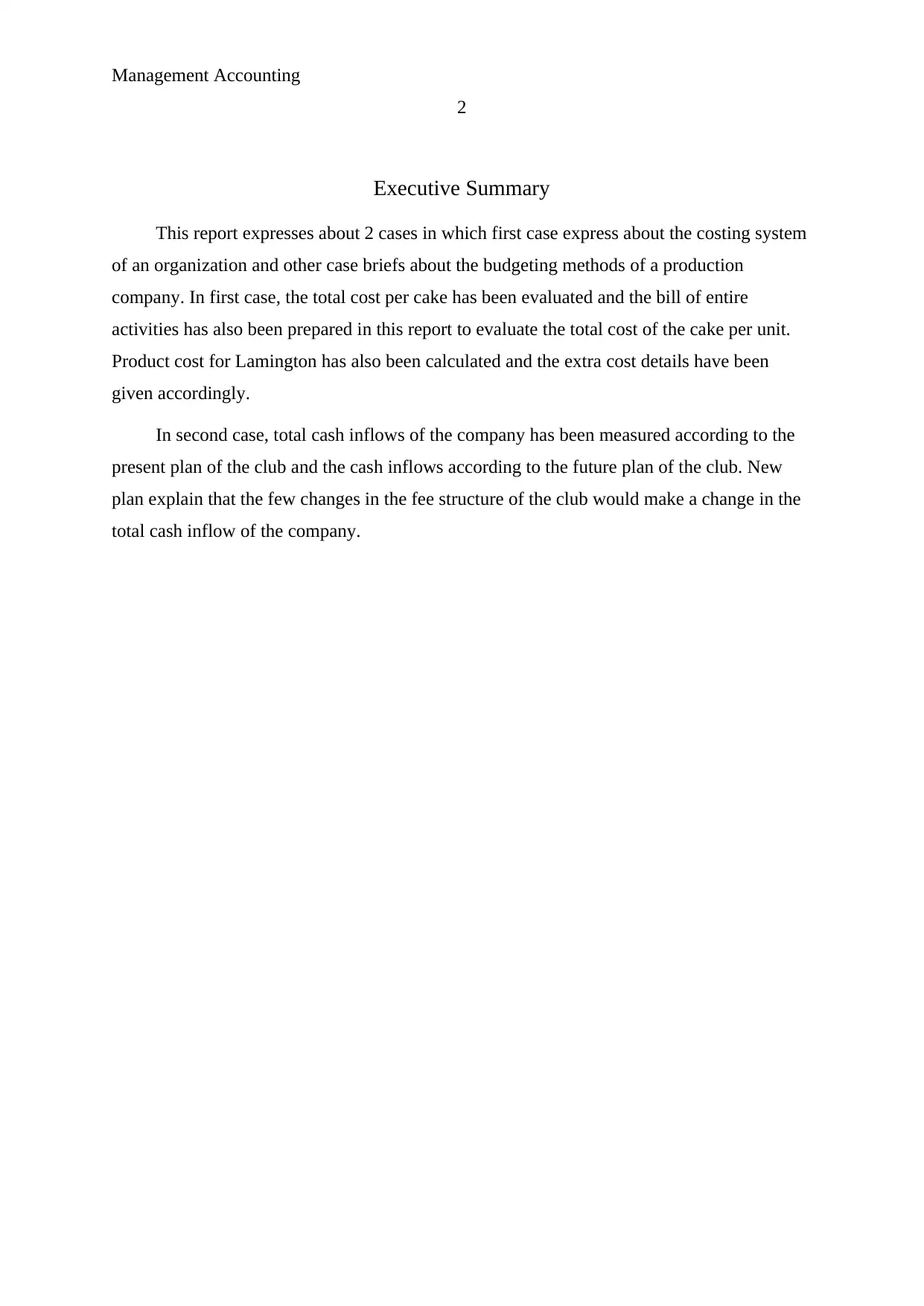
Management Accounting
2
Executive Summary
This report expresses about 2 cases in which first case express about the costing system
of an organization and other case briefs about the budgeting methods of a production
company. In first case, the total cost per cake has been evaluated and the bill of entire
activities has also been prepared in this report to evaluate the total cost of the cake per unit.
Product cost for Lamington has also been calculated and the extra cost details have been
given accordingly.
In second case, total cash inflows of the company has been measured according to the
present plan of the club and the cash inflows according to the future plan of the club. New
plan explain that the few changes in the fee structure of the club would make a change in the
total cash inflow of the company.
2
Executive Summary
This report expresses about 2 cases in which first case express about the costing system
of an organization and other case briefs about the budgeting methods of a production
company. In first case, the total cost per cake has been evaluated and the bill of entire
activities has also been prepared in this report to evaluate the total cost of the cake per unit.
Product cost for Lamington has also been calculated and the extra cost details have been
given accordingly.
In second case, total cash inflows of the company has been measured according to the
present plan of the club and the cash inflows according to the future plan of the club. New
plan explain that the few changes in the fee structure of the club would make a change in the
total cash inflow of the company.
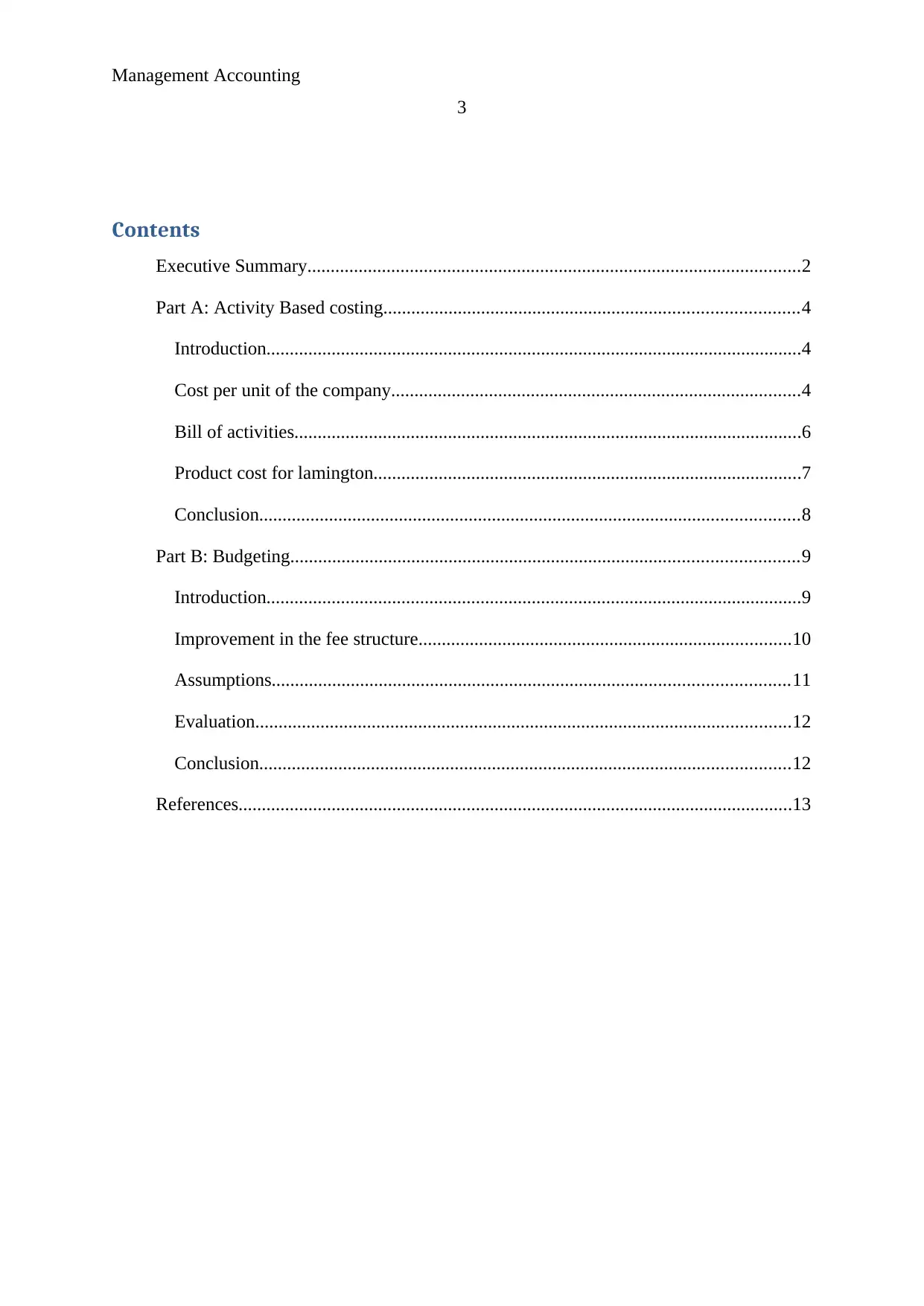
Management Accounting
3
Contents
Executive Summary..........................................................................................................2
Part A: Activity Based costing.........................................................................................4
Introduction...................................................................................................................4
Cost per unit of the company........................................................................................4
Bill of activities.............................................................................................................6
Product cost for lamington............................................................................................7
Conclusion....................................................................................................................8
Part B: Budgeting.............................................................................................................9
Introduction...................................................................................................................9
Improvement in the fee structure................................................................................10
Assumptions...............................................................................................................11
Evaluation...................................................................................................................12
Conclusion..................................................................................................................12
References.......................................................................................................................13
3
Contents
Executive Summary..........................................................................................................2
Part A: Activity Based costing.........................................................................................4
Introduction...................................................................................................................4
Cost per unit of the company........................................................................................4
Bill of activities.............................................................................................................6
Product cost for lamington............................................................................................7
Conclusion....................................................................................................................8
Part B: Budgeting.............................................................................................................9
Introduction...................................................................................................................9
Improvement in the fee structure................................................................................10
Assumptions...............................................................................................................11
Evaluation...................................................................................................................12
Conclusion..................................................................................................................12
References.......................................................................................................................13
⊘ This is a preview!⊘
Do you want full access?
Subscribe today to unlock all pages.

Trusted by 1+ million students worldwide
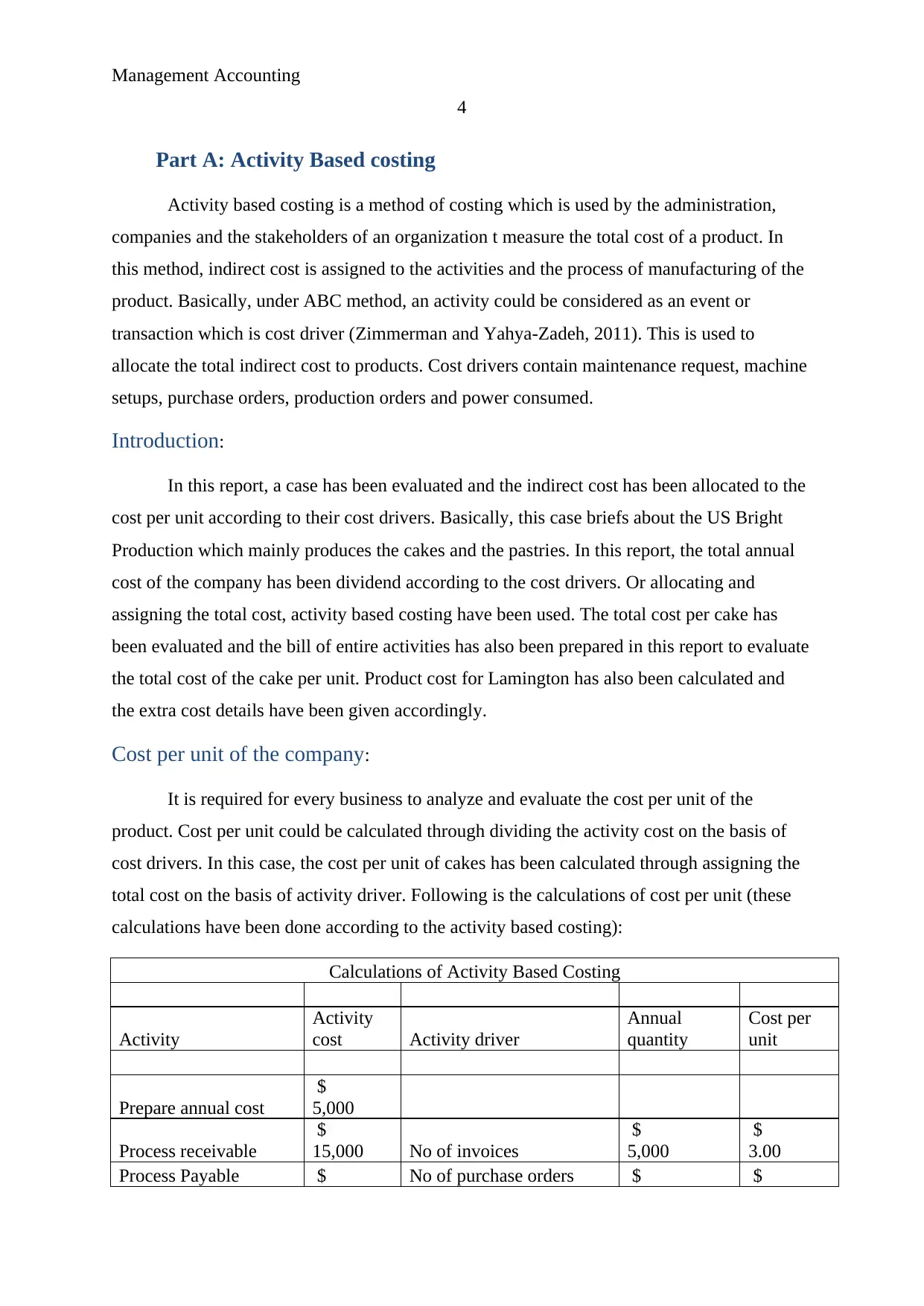
Management Accounting
4
Part A: Activity Based costing
Activity based costing is a method of costing which is used by the administration,
companies and the stakeholders of an organization t measure the total cost of a product. In
this method, indirect cost is assigned to the activities and the process of manufacturing of the
product. Basically, under ABC method, an activity could be considered as an event or
transaction which is cost driver (Zimmerman and Yahya-Zadeh, 2011). This is used to
allocate the total indirect cost to products. Cost drivers contain maintenance request, machine
setups, purchase orders, production orders and power consumed.
Introduction:
In this report, a case has been evaluated and the indirect cost has been allocated to the
cost per unit according to their cost drivers. Basically, this case briefs about the US Bright
Production which mainly produces the cakes and the pastries. In this report, the total annual
cost of the company has been dividend according to the cost drivers. Or allocating and
assigning the total cost, activity based costing have been used. The total cost per cake has
been evaluated and the bill of entire activities has also been prepared in this report to evaluate
the total cost of the cake per unit. Product cost for Lamington has also been calculated and
the extra cost details have been given accordingly.
Cost per unit of the company:
It is required for every business to analyze and evaluate the cost per unit of the
product. Cost per unit could be calculated through dividing the activity cost on the basis of
cost drivers. In this case, the cost per unit of cakes has been calculated through assigning the
total cost on the basis of activity driver. Following is the calculations of cost per unit (these
calculations have been done according to the activity based costing):
Calculations of Activity Based Costing
Activity
Activity
cost Activity driver
Annual
quantity
Cost per
unit
Prepare annual cost
$
5,000
Process receivable
$
15,000 No of invoices
$
5,000
$
3.00
Process Payable $ No of purchase orders $ $
4
Part A: Activity Based costing
Activity based costing is a method of costing which is used by the administration,
companies and the stakeholders of an organization t measure the total cost of a product. In
this method, indirect cost is assigned to the activities and the process of manufacturing of the
product. Basically, under ABC method, an activity could be considered as an event or
transaction which is cost driver (Zimmerman and Yahya-Zadeh, 2011). This is used to
allocate the total indirect cost to products. Cost drivers contain maintenance request, machine
setups, purchase orders, production orders and power consumed.
Introduction:
In this report, a case has been evaluated and the indirect cost has been allocated to the
cost per unit according to their cost drivers. Basically, this case briefs about the US Bright
Production which mainly produces the cakes and the pastries. In this report, the total annual
cost of the company has been dividend according to the cost drivers. Or allocating and
assigning the total cost, activity based costing have been used. The total cost per cake has
been evaluated and the bill of entire activities has also been prepared in this report to evaluate
the total cost of the cake per unit. Product cost for Lamington has also been calculated and
the extra cost details have been given accordingly.
Cost per unit of the company:
It is required for every business to analyze and evaluate the cost per unit of the
product. Cost per unit could be calculated through dividing the activity cost on the basis of
cost drivers. In this case, the cost per unit of cakes has been calculated through assigning the
total cost on the basis of activity driver. Following is the calculations of cost per unit (these
calculations have been done according to the activity based costing):
Calculations of Activity Based Costing
Activity
Activity
cost Activity driver
Annual
quantity
Cost per
unit
Prepare annual cost
$
5,000
Process receivable
$
15,000 No of invoices
$
5,000
$
3.00
Process Payable $ No of purchase orders $ $
Paraphrase This Document
Need a fresh take? Get an instant paraphrase of this document with our AI Paraphraser
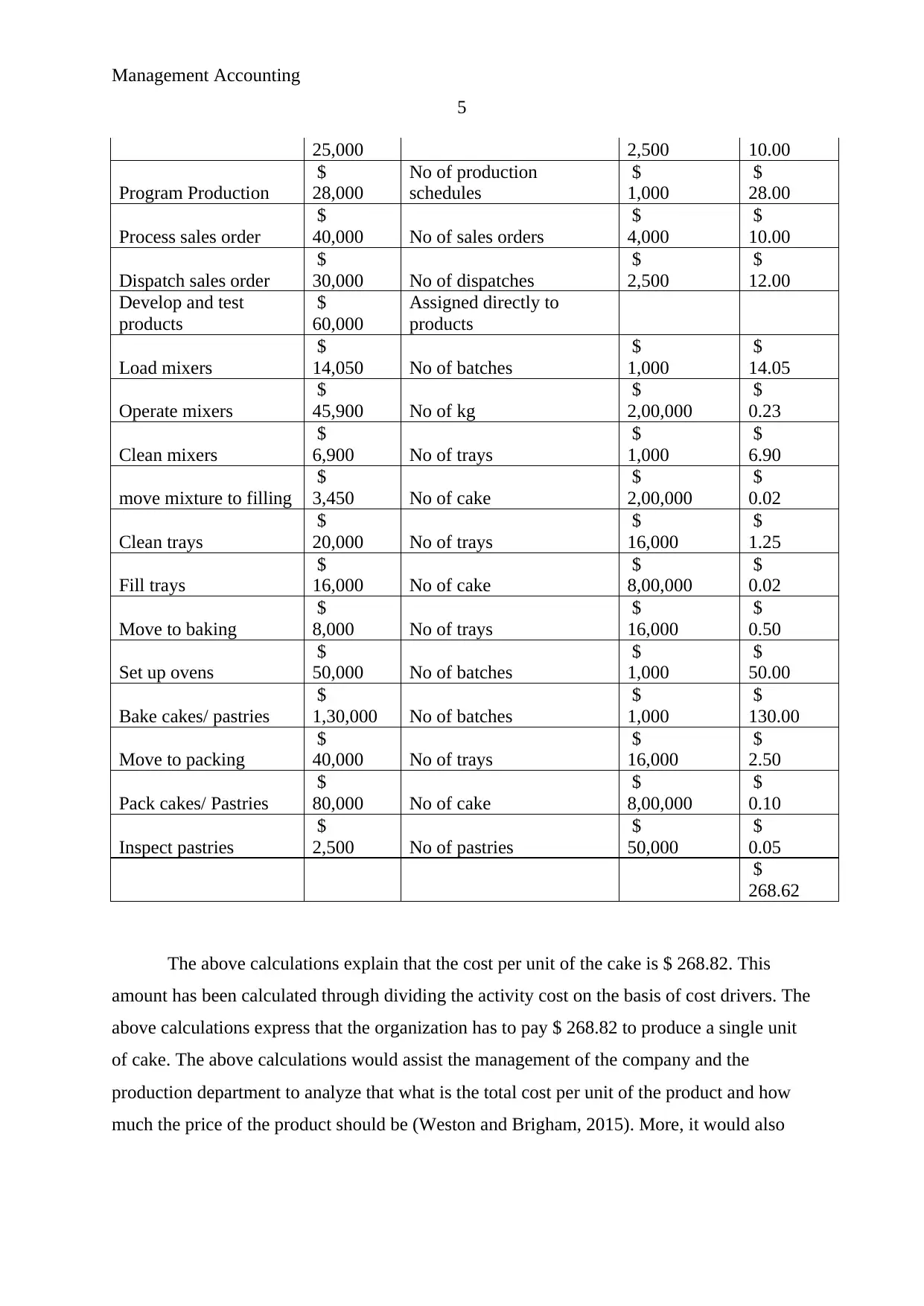
Management Accounting
5
25,000 2,500 10.00
Program Production
$
28,000
No of production
schedules
$
1,000
$
28.00
Process sales order
$
40,000 No of sales orders
$
4,000
$
10.00
Dispatch sales order
$
30,000 No of dispatches
$
2,500
$
12.00
Develop and test
products
$
60,000
Assigned directly to
products
Load mixers
$
14,050 No of batches
$
1,000
$
14.05
Operate mixers
$
45,900 No of kg
$
2,00,000
$
0.23
Clean mixers
$
6,900 No of trays
$
1,000
$
6.90
move mixture to filling
$
3,450 No of cake
$
2,00,000
$
0.02
Clean trays
$
20,000 No of trays
$
16,000
$
1.25
Fill trays
$
16,000 No of cake
$
8,00,000
$
0.02
Move to baking
$
8,000 No of trays
$
16,000
$
0.50
Set up ovens
$
50,000 No of batches
$
1,000
$
50.00
Bake cakes/ pastries
$
1,30,000 No of batches
$
1,000
$
130.00
Move to packing
$
40,000 No of trays
$
16,000
$
2.50
Pack cakes/ Pastries
$
80,000 No of cake
$
8,00,000
$
0.10
Inspect pastries
$
2,500 No of pastries
$
50,000
$
0.05
$
268.62
The above calculations explain that the cost per unit of the cake is $ 268.82. This
amount has been calculated through dividing the activity cost on the basis of cost drivers. The
above calculations express that the organization has to pay $ 268.82 to produce a single unit
of cake. The above calculations would assist the management of the company and the
production department to analyze that what is the total cost per unit of the product and how
much the price of the product should be (Weston and Brigham, 2015). More, it would also
5
25,000 2,500 10.00
Program Production
$
28,000
No of production
schedules
$
1,000
$
28.00
Process sales order
$
40,000 No of sales orders
$
4,000
$
10.00
Dispatch sales order
$
30,000 No of dispatches
$
2,500
$
12.00
Develop and test
products
$
60,000
Assigned directly to
products
Load mixers
$
14,050 No of batches
$
1,000
$
14.05
Operate mixers
$
45,900 No of kg
$
2,00,000
$
0.23
Clean mixers
$
6,900 No of trays
$
1,000
$
6.90
move mixture to filling
$
3,450 No of cake
$
2,00,000
$
0.02
Clean trays
$
20,000 No of trays
$
16,000
$
1.25
Fill trays
$
16,000 No of cake
$
8,00,000
$
0.02
Move to baking
$
8,000 No of trays
$
16,000
$
0.50
Set up ovens
$
50,000 No of batches
$
1,000
$
50.00
Bake cakes/ pastries
$
1,30,000 No of batches
$
1,000
$
130.00
Move to packing
$
40,000 No of trays
$
16,000
$
2.50
Pack cakes/ Pastries
$
80,000 No of cake
$
8,00,000
$
0.10
Inspect pastries
$
2,500 No of pastries
$
50,000
$
0.05
$
268.62
The above calculations explain that the cost per unit of the cake is $ 268.82. This
amount has been calculated through dividing the activity cost on the basis of cost drivers. The
above calculations express that the organization has to pay $ 268.82 to produce a single unit
of cake. The above calculations would assist the management of the company and the
production department to analyze that what is the total cost per unit of the product and how
much the price of the product should be (Weston and Brigham, 2015). More, it would also
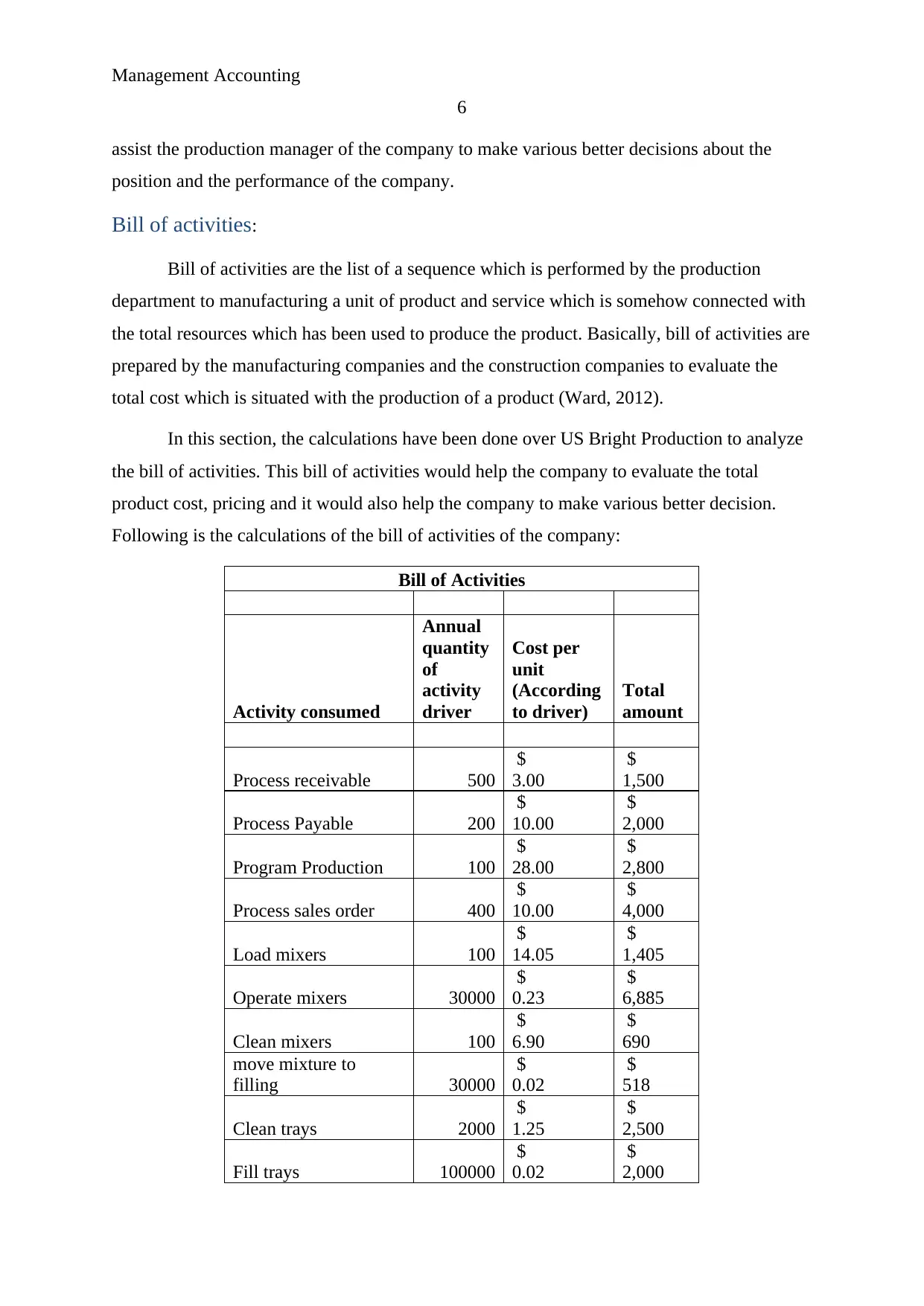
Management Accounting
6
assist the production manager of the company to make various better decisions about the
position and the performance of the company.
Bill of activities:
Bill of activities are the list of a sequence which is performed by the production
department to manufacturing a unit of product and service which is somehow connected with
the total resources which has been used to produce the product. Basically, bill of activities are
prepared by the manufacturing companies and the construction companies to evaluate the
total cost which is situated with the production of a product (Ward, 2012).
In this section, the calculations have been done over US Bright Production to analyze
the bill of activities. This bill of activities would help the company to evaluate the total
product cost, pricing and it would also help the company to make various better decision.
Following is the calculations of the bill of activities of the company:
Bill of Activities
Activity consumed
Annual
quantity
of
activity
driver
Cost per
unit
(According
to driver)
Total
amount
Process receivable 500
$
3.00
$
1,500
Process Payable 200
$
10.00
$
2,000
Program Production 100
$
28.00
$
2,800
Process sales order 400
$
10.00
$
4,000
Load mixers 100
$
14.05
$
1,405
Operate mixers 30000
$
0.23
$
6,885
Clean mixers 100
$
6.90
$
690
move mixture to
filling 30000
$
0.02
$
518
Clean trays 2000
$
1.25
$
2,500
Fill trays 100000
$
0.02
$
2,000
6
assist the production manager of the company to make various better decisions about the
position and the performance of the company.
Bill of activities:
Bill of activities are the list of a sequence which is performed by the production
department to manufacturing a unit of product and service which is somehow connected with
the total resources which has been used to produce the product. Basically, bill of activities are
prepared by the manufacturing companies and the construction companies to evaluate the
total cost which is situated with the production of a product (Ward, 2012).
In this section, the calculations have been done over US Bright Production to analyze
the bill of activities. This bill of activities would help the company to evaluate the total
product cost, pricing and it would also help the company to make various better decision.
Following is the calculations of the bill of activities of the company:
Bill of Activities
Activity consumed
Annual
quantity
of
activity
driver
Cost per
unit
(According
to driver)
Total
amount
Process receivable 500
$
3.00
$
1,500
Process Payable 200
$
10.00
$
2,000
Program Production 100
$
28.00
$
2,800
Process sales order 400
$
10.00
$
4,000
Load mixers 100
$
14.05
$
1,405
Operate mixers 30000
$
0.23
$
6,885
Clean mixers 100
$
6.90
$
690
move mixture to
filling 30000
$
0.02
$
518
Clean trays 2000
$
1.25
$
2,500
Fill trays 100000
$
0.02
$
2,000
⊘ This is a preview!⊘
Do you want full access?
Subscribe today to unlock all pages.

Trusted by 1+ million students worldwide
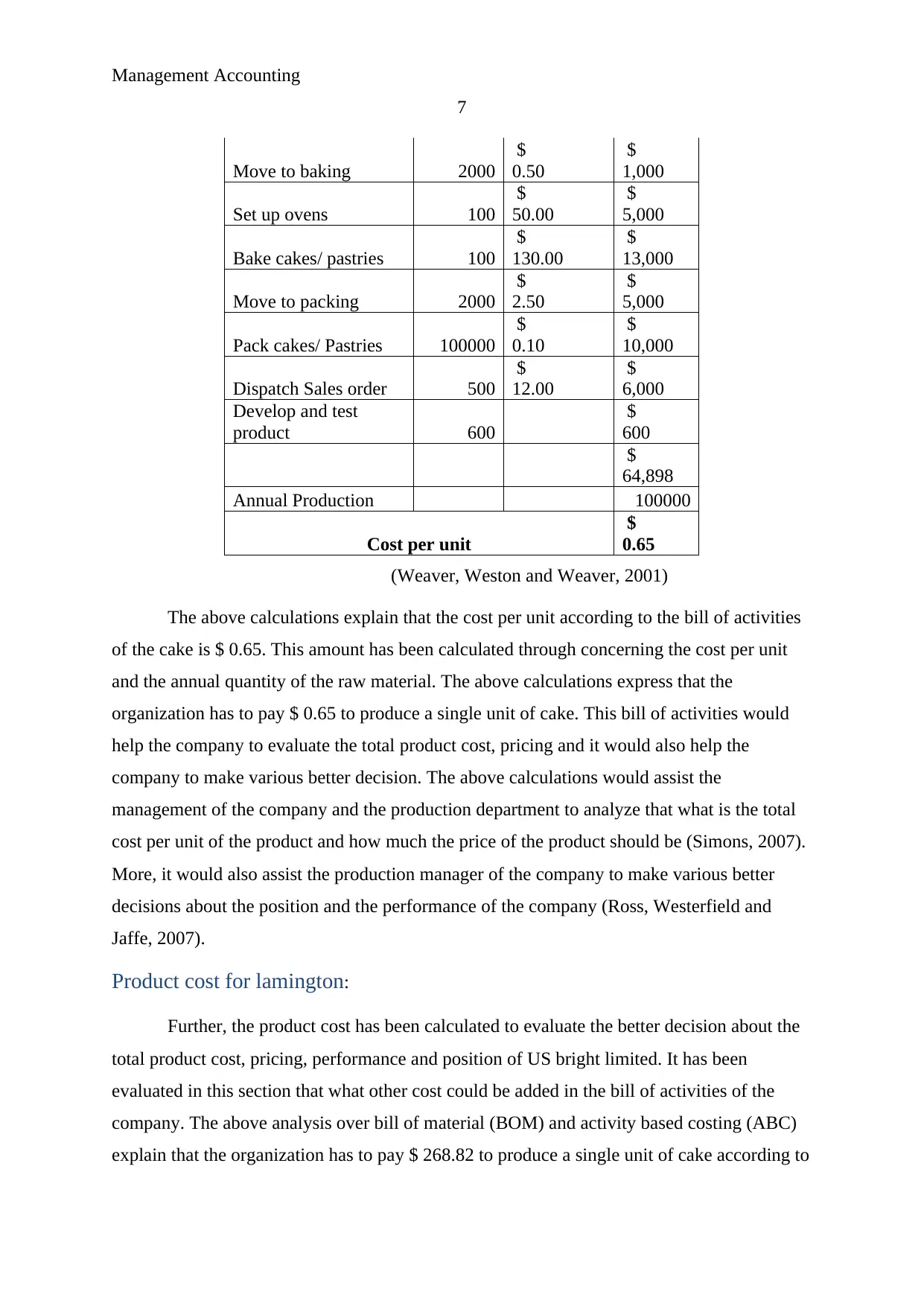
Management Accounting
7
Move to baking 2000
$
0.50
$
1,000
Set up ovens 100
$
50.00
$
5,000
Bake cakes/ pastries 100
$
130.00
$
13,000
Move to packing 2000
$
2.50
$
5,000
Pack cakes/ Pastries 100000
$
0.10
$
10,000
Dispatch Sales order 500
$
12.00
$
6,000
Develop and test
product 600
$
600
$
64,898
Annual Production 100000
Cost per unit
$
0.65
(Weaver, Weston and Weaver, 2001)
The above calculations explain that the cost per unit according to the bill of activities
of the cake is $ 0.65. This amount has been calculated through concerning the cost per unit
and the annual quantity of the raw material. The above calculations express that the
organization has to pay $ 0.65 to produce a single unit of cake. This bill of activities would
help the company to evaluate the total product cost, pricing and it would also help the
company to make various better decision. The above calculations would assist the
management of the company and the production department to analyze that what is the total
cost per unit of the product and how much the price of the product should be (Simons, 2007).
More, it would also assist the production manager of the company to make various better
decisions about the position and the performance of the company (Ross, Westerfield and
Jaffe, 2007).
Product cost for lamington:
Further, the product cost has been calculated to evaluate the better decision about the
total product cost, pricing, performance and position of US bright limited. It has been
evaluated in this section that what other cost could be added in the bill of activities of the
company. The above analysis over bill of material (BOM) and activity based costing (ABC)
explain that the organization has to pay $ 268.82 to produce a single unit of cake according to
7
Move to baking 2000
$
0.50
$
1,000
Set up ovens 100
$
50.00
$
5,000
Bake cakes/ pastries 100
$
130.00
$
13,000
Move to packing 2000
$
2.50
$
5,000
Pack cakes/ Pastries 100000
$
0.10
$
10,000
Dispatch Sales order 500
$
12.00
$
6,000
Develop and test
product 600
$
600
$
64,898
Annual Production 100000
Cost per unit
$
0.65
(Weaver, Weston and Weaver, 2001)
The above calculations explain that the cost per unit according to the bill of activities
of the cake is $ 0.65. This amount has been calculated through concerning the cost per unit
and the annual quantity of the raw material. The above calculations express that the
organization has to pay $ 0.65 to produce a single unit of cake. This bill of activities would
help the company to evaluate the total product cost, pricing and it would also help the
company to make various better decision. The above calculations would assist the
management of the company and the production department to analyze that what is the total
cost per unit of the product and how much the price of the product should be (Simons, 2007).
More, it would also assist the production manager of the company to make various better
decisions about the position and the performance of the company (Ross, Westerfield and
Jaffe, 2007).
Product cost for lamington:
Further, the product cost has been calculated to evaluate the better decision about the
total product cost, pricing, performance and position of US bright limited. It has been
evaluated in this section that what other cost could be added in the bill of activities of the
company. The above analysis over bill of material (BOM) and activity based costing (ABC)
explain that the organization has to pay $ 268.82 to produce a single unit of cake according to
Paraphrase This Document
Need a fresh take? Get an instant paraphrase of this document with our AI Paraphraser
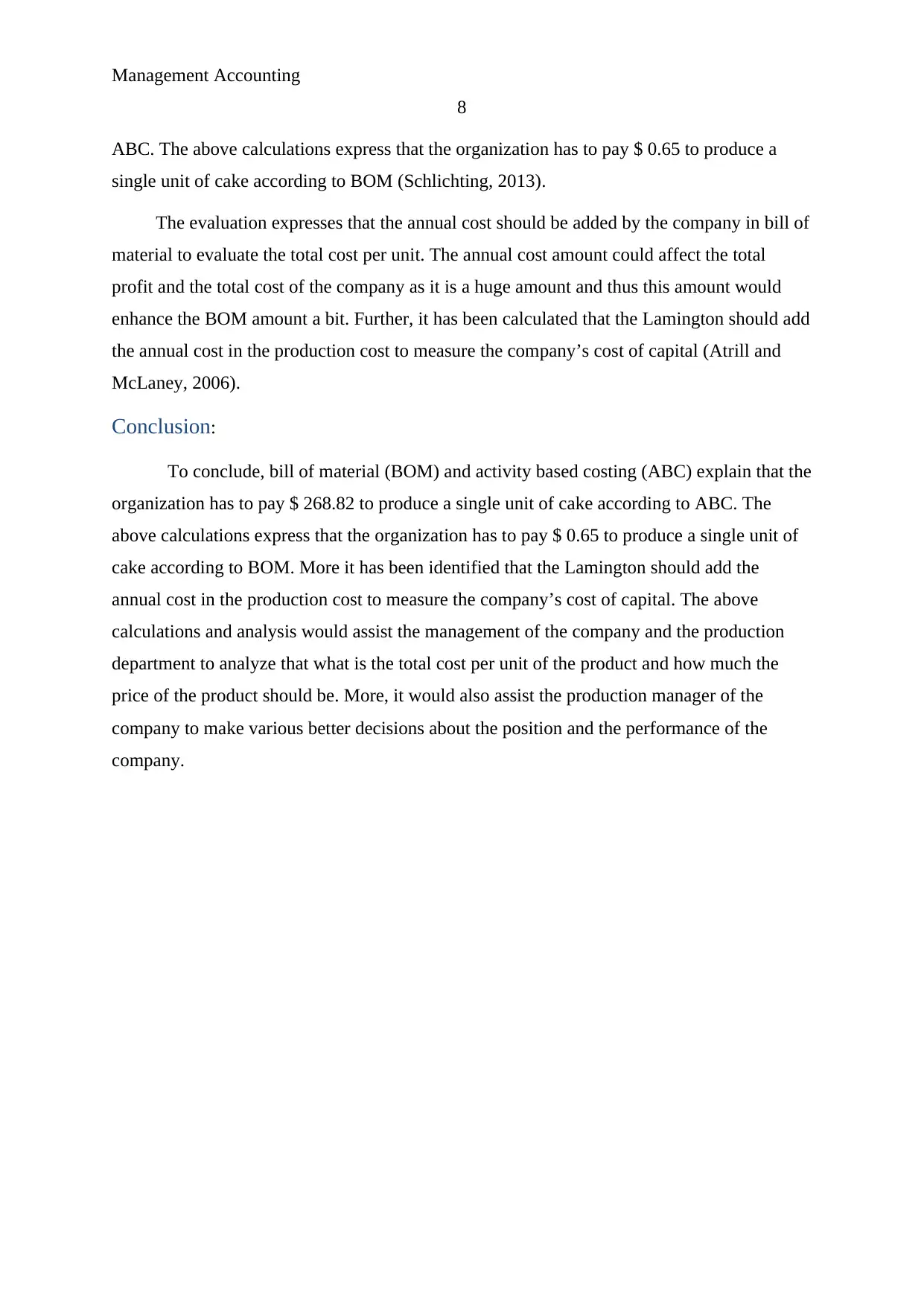
Management Accounting
8
ABC. The above calculations express that the organization has to pay $ 0.65 to produce a
single unit of cake according to BOM (Schlichting, 2013).
The evaluation expresses that the annual cost should be added by the company in bill of
material to evaluate the total cost per unit. The annual cost amount could affect the total
profit and the total cost of the company as it is a huge amount and thus this amount would
enhance the BOM amount a bit. Further, it has been calculated that the Lamington should add
the annual cost in the production cost to measure the company’s cost of capital (Atrill and
McLaney, 2006).
Conclusion:
To conclude, bill of material (BOM) and activity based costing (ABC) explain that the
organization has to pay $ 268.82 to produce a single unit of cake according to ABC. The
above calculations express that the organization has to pay $ 0.65 to produce a single unit of
cake according to BOM. More it has been identified that the Lamington should add the
annual cost in the production cost to measure the company’s cost of capital. The above
calculations and analysis would assist the management of the company and the production
department to analyze that what is the total cost per unit of the product and how much the
price of the product should be. More, it would also assist the production manager of the
company to make various better decisions about the position and the performance of the
company.
8
ABC. The above calculations express that the organization has to pay $ 0.65 to produce a
single unit of cake according to BOM (Schlichting, 2013).
The evaluation expresses that the annual cost should be added by the company in bill of
material to evaluate the total cost per unit. The annual cost amount could affect the total
profit and the total cost of the company as it is a huge amount and thus this amount would
enhance the BOM amount a bit. Further, it has been calculated that the Lamington should add
the annual cost in the production cost to measure the company’s cost of capital (Atrill and
McLaney, 2006).
Conclusion:
To conclude, bill of material (BOM) and activity based costing (ABC) explain that the
organization has to pay $ 268.82 to produce a single unit of cake according to ABC. The
above calculations express that the organization has to pay $ 0.65 to produce a single unit of
cake according to BOM. More it has been identified that the Lamington should add the
annual cost in the production cost to measure the company’s cost of capital. The above
calculations and analysis would assist the management of the company and the production
department to analyze that what is the total cost per unit of the product and how much the
price of the product should be. More, it would also assist the production manager of the
company to make various better decisions about the position and the performance of the
company.
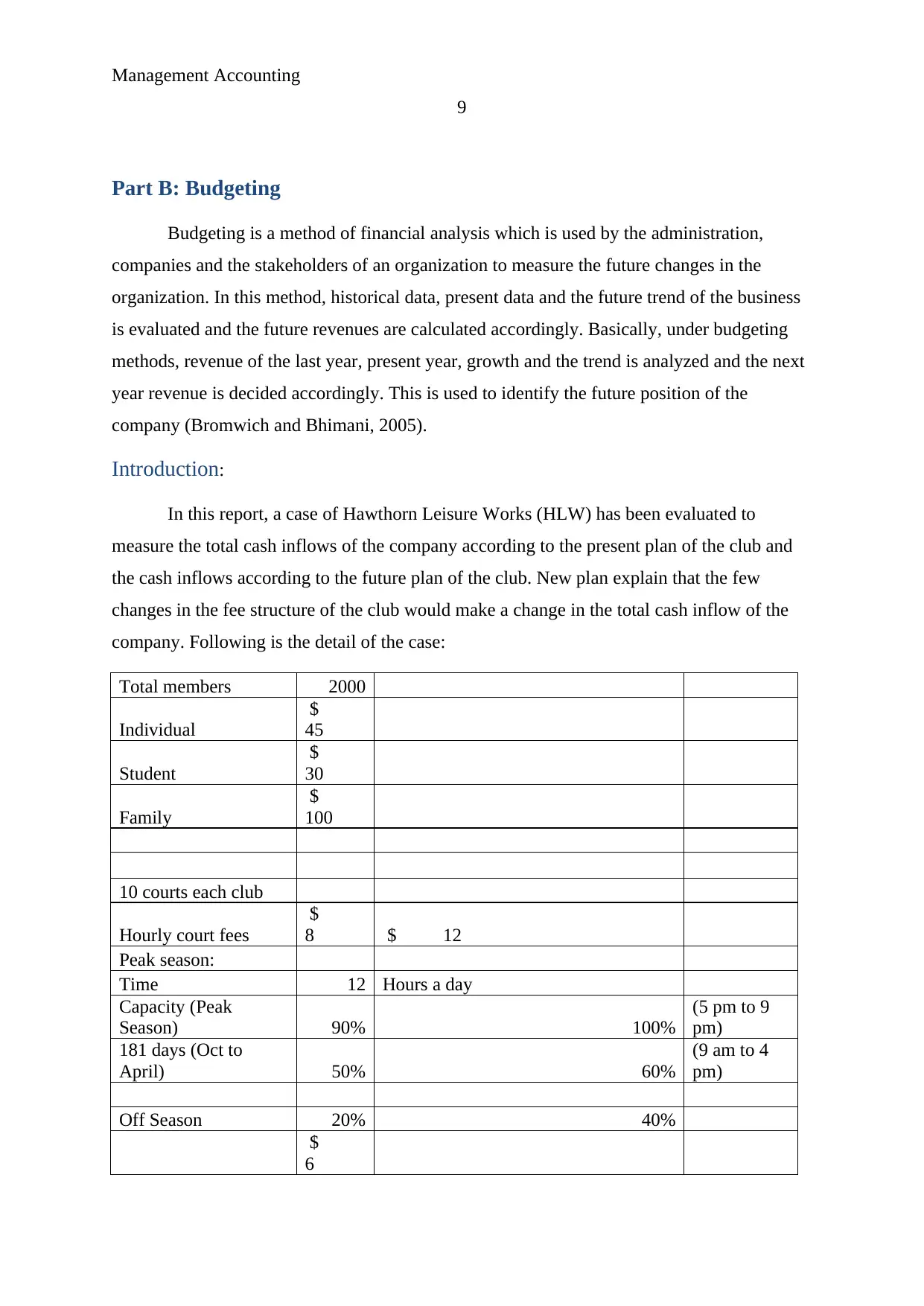
Management Accounting
9
Part B: Budgeting
Budgeting is a method of financial analysis which is used by the administration,
companies and the stakeholders of an organization to measure the future changes in the
organization. In this method, historical data, present data and the future trend of the business
is evaluated and the future revenues are calculated accordingly. Basically, under budgeting
methods, revenue of the last year, present year, growth and the trend is analyzed and the next
year revenue is decided accordingly. This is used to identify the future position of the
company (Bromwich and Bhimani, 2005).
Introduction:
In this report, a case of Hawthorn Leisure Works (HLW) has been evaluated to
measure the total cash inflows of the company according to the present plan of the club and
the cash inflows according to the future plan of the club. New plan explain that the few
changes in the fee structure of the club would make a change in the total cash inflow of the
company. Following is the detail of the case:
Total members 2000
Individual
$
45
Student
$
30
Family
$
100
10 courts each club
Hourly court fees
$
8 $ 12
Peak season:
Time 12 Hours a day
Capacity (Peak
Season) 90% 100%
(5 pm to 9
pm)
181 days (Oct to
April) 50% 60%
(9 am to 4
pm)
Off Season 20% 40%
$
6
9
Part B: Budgeting
Budgeting is a method of financial analysis which is used by the administration,
companies and the stakeholders of an organization to measure the future changes in the
organization. In this method, historical data, present data and the future trend of the business
is evaluated and the future revenues are calculated accordingly. Basically, under budgeting
methods, revenue of the last year, present year, growth and the trend is analyzed and the next
year revenue is decided accordingly. This is used to identify the future position of the
company (Bromwich and Bhimani, 2005).
Introduction:
In this report, a case of Hawthorn Leisure Works (HLW) has been evaluated to
measure the total cash inflows of the company according to the present plan of the club and
the cash inflows according to the future plan of the club. New plan explain that the few
changes in the fee structure of the club would make a change in the total cash inflow of the
company. Following is the detail of the case:
Total members 2000
Individual
$
45
Student
$
30
Family
$
100
10 courts each club
Hourly court fees
$
8 $ 12
Peak season:
Time 12 Hours a day
Capacity (Peak
Season) 90% 100%
(5 pm to 9
pm)
181 days (Oct to
April) 50% 60%
(9 am to 4
pm)
Off Season 20% 40%
$
6
⊘ This is a preview!⊘
Do you want full access?
Subscribe today to unlock all pages.

Trusted by 1+ million students worldwide
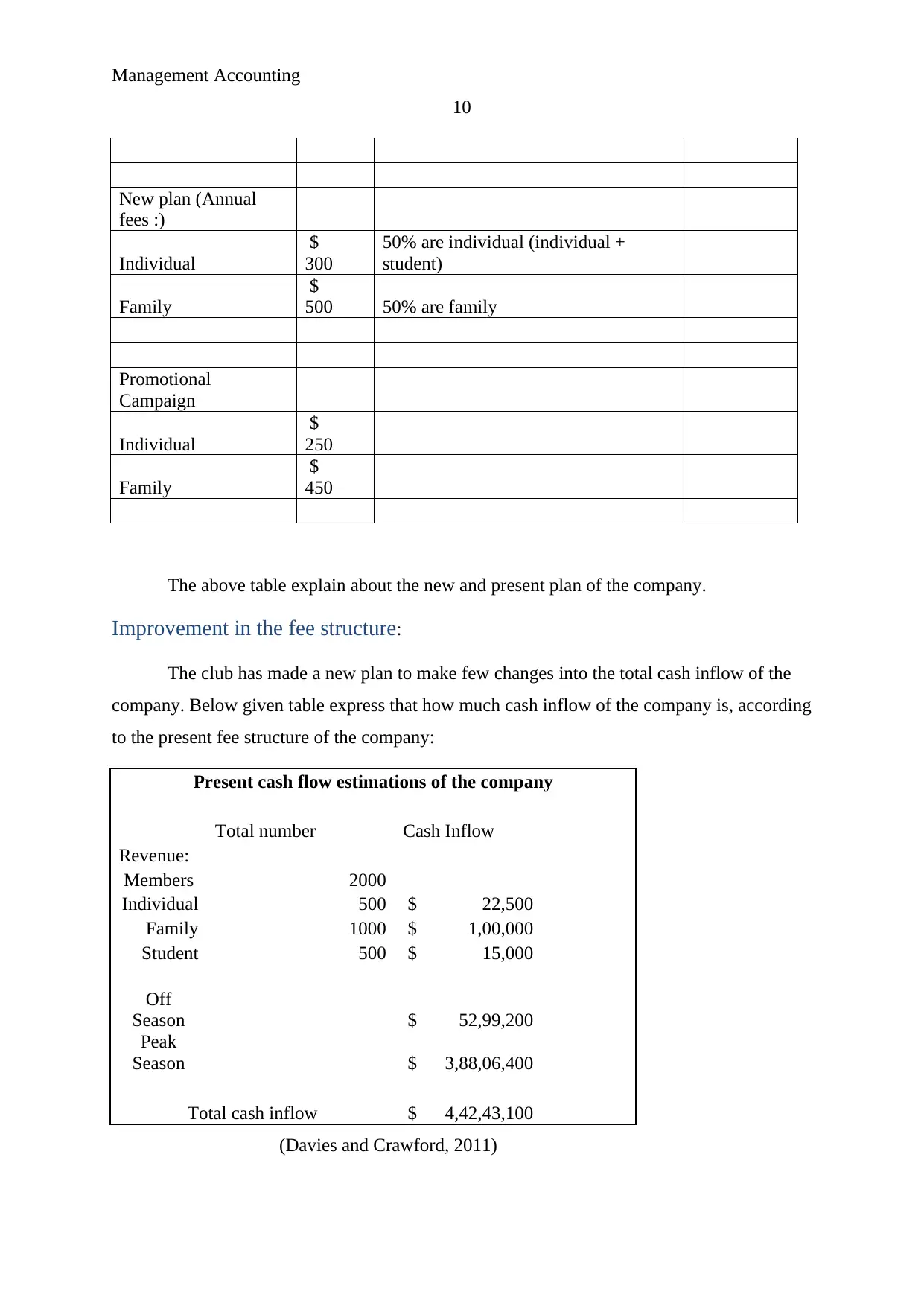
Management Accounting
10
New plan (Annual
fees :)
Individual
$
300
50% are individual (individual +
student)
Family
$
500 50% are family
Promotional
Campaign
Individual
$
250
Family
$
450
The above table explain about the new and present plan of the company.
Improvement in the fee structure:
The club has made a new plan to make few changes into the total cash inflow of the
company. Below given table express that how much cash inflow of the company is, according
to the present fee structure of the company:
Present cash flow estimations of the company
Total number Cash Inflow
Revenue:
Members 2000
Individual 500 $ 22,500
Family 1000 $ 1,00,000
Student 500 $ 15,000
Off
Season $ 52,99,200
Peak
Season $ 3,88,06,400
Total cash inflow $ 4,42,43,100
(Davies and Crawford, 2011)
10
New plan (Annual
fees :)
Individual
$
300
50% are individual (individual +
student)
Family
$
500 50% are family
Promotional
Campaign
Individual
$
250
Family
$
450
The above table explain about the new and present plan of the company.
Improvement in the fee structure:
The club has made a new plan to make few changes into the total cash inflow of the
company. Below given table express that how much cash inflow of the company is, according
to the present fee structure of the company:
Present cash flow estimations of the company
Total number Cash Inflow
Revenue:
Members 2000
Individual 500 $ 22,500
Family 1000 $ 1,00,000
Student 500 $ 15,000
Off
Season $ 52,99,200
Peak
Season $ 3,88,06,400
Total cash inflow $ 4,42,43,100
(Davies and Crawford, 2011)
Paraphrase This Document
Need a fresh take? Get an instant paraphrase of this document with our AI Paraphraser
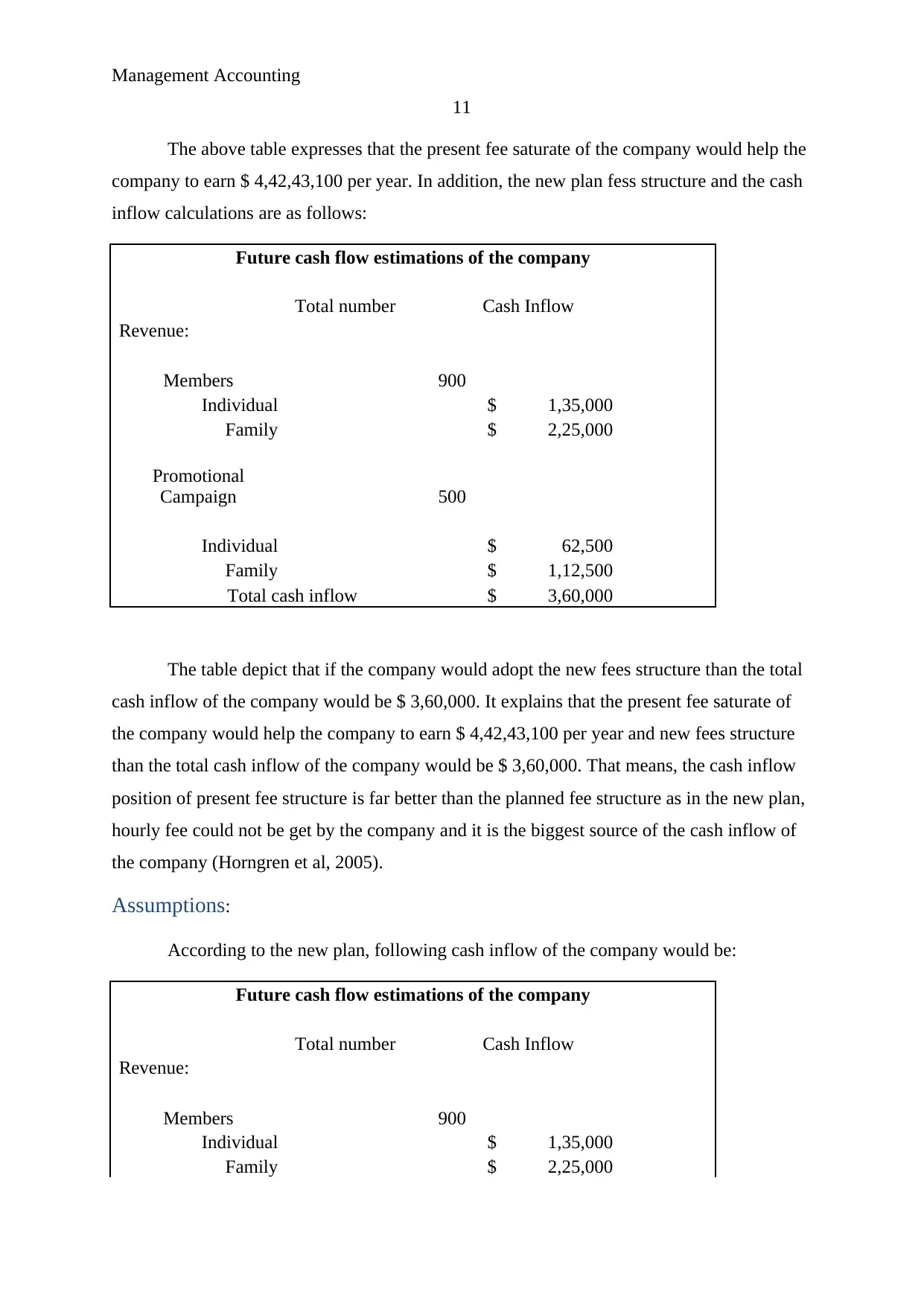
Management Accounting
11
The above table expresses that the present fee saturate of the company would help the
company to earn $ 4,42,43,100 per year. In addition, the new plan fess structure and the cash
inflow calculations are as follows:
Future cash flow estimations of the company
Total number Cash Inflow
Revenue:
Members 900
Individual $ 1,35,000
Family $ 2,25,000
Promotional
Campaign 500
Individual $ 62,500
Family $ 1,12,500
Total cash inflow $ 3,60,000
The table depict that if the company would adopt the new fees structure than the total
cash inflow of the company would be $ 3,60,000. It explains that the present fee saturate of
the company would help the company to earn $ 4,42,43,100 per year and new fees structure
than the total cash inflow of the company would be $ 3,60,000. That means, the cash inflow
position of present fee structure is far better than the planned fee structure as in the new plan,
hourly fee could not be get by the company and it is the biggest source of the cash inflow of
the company (Horngren et al, 2005).
Assumptions:
According to the new plan, following cash inflow of the company would be:
Future cash flow estimations of the company
Total number Cash Inflow
Revenue:
Members 900
Individual $ 1,35,000
Family $ 2,25,000
11
The above table expresses that the present fee saturate of the company would help the
company to earn $ 4,42,43,100 per year. In addition, the new plan fess structure and the cash
inflow calculations are as follows:
Future cash flow estimations of the company
Total number Cash Inflow
Revenue:
Members 900
Individual $ 1,35,000
Family $ 2,25,000
Promotional
Campaign 500
Individual $ 62,500
Family $ 1,12,500
Total cash inflow $ 3,60,000
The table depict that if the company would adopt the new fees structure than the total
cash inflow of the company would be $ 3,60,000. It explains that the present fee saturate of
the company would help the company to earn $ 4,42,43,100 per year and new fees structure
than the total cash inflow of the company would be $ 3,60,000. That means, the cash inflow
position of present fee structure is far better than the planned fee structure as in the new plan,
hourly fee could not be get by the company and it is the biggest source of the cash inflow of
the company (Horngren et al, 2005).
Assumptions:
According to the new plan, following cash inflow of the company would be:
Future cash flow estimations of the company
Total number Cash Inflow
Revenue:
Members 900
Individual $ 1,35,000
Family $ 2,25,000
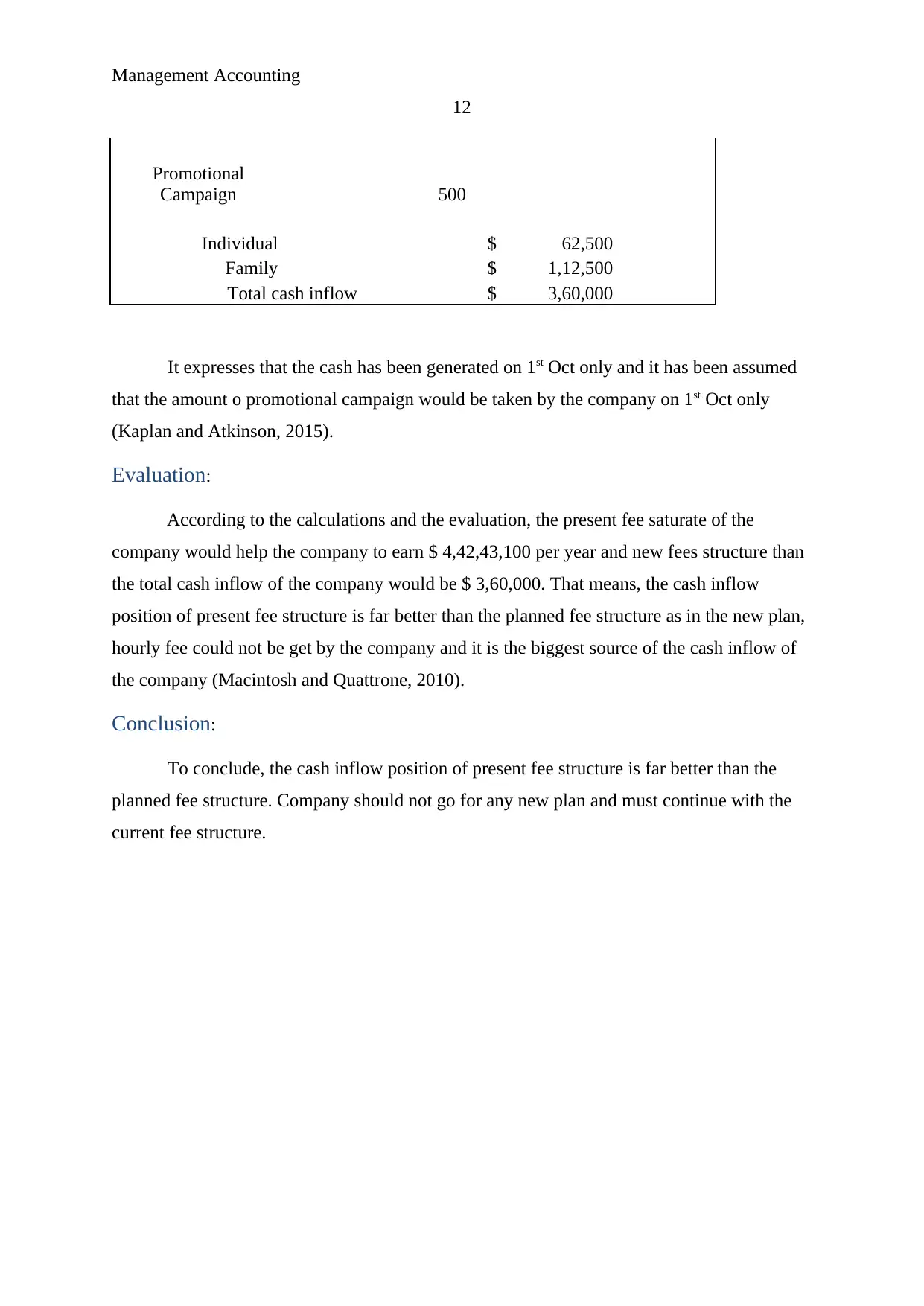
Management Accounting
12
Promotional
Campaign 500
Individual $ 62,500
Family $ 1,12,500
Total cash inflow $ 3,60,000
It expresses that the cash has been generated on 1st Oct only and it has been assumed
that the amount o promotional campaign would be taken by the company on 1st Oct only
(Kaplan and Atkinson, 2015).
Evaluation:
According to the calculations and the evaluation, the present fee saturate of the
company would help the company to earn $ 4,42,43,100 per year and new fees structure than
the total cash inflow of the company would be $ 3,60,000. That means, the cash inflow
position of present fee structure is far better than the planned fee structure as in the new plan,
hourly fee could not be get by the company and it is the biggest source of the cash inflow of
the company (Macintosh and Quattrone, 2010).
Conclusion:
To conclude, the cash inflow position of present fee structure is far better than the
planned fee structure. Company should not go for any new plan and must continue with the
current fee structure.
12
Promotional
Campaign 500
Individual $ 62,500
Family $ 1,12,500
Total cash inflow $ 3,60,000
It expresses that the cash has been generated on 1st Oct only and it has been assumed
that the amount o promotional campaign would be taken by the company on 1st Oct only
(Kaplan and Atkinson, 2015).
Evaluation:
According to the calculations and the evaluation, the present fee saturate of the
company would help the company to earn $ 4,42,43,100 per year and new fees structure than
the total cash inflow of the company would be $ 3,60,000. That means, the cash inflow
position of present fee structure is far better than the planned fee structure as in the new plan,
hourly fee could not be get by the company and it is the biggest source of the cash inflow of
the company (Macintosh and Quattrone, 2010).
Conclusion:
To conclude, the cash inflow position of present fee structure is far better than the
planned fee structure. Company should not go for any new plan and must continue with the
current fee structure.
⊘ This is a preview!⊘
Do you want full access?
Subscribe today to unlock all pages.

Trusted by 1+ million students worldwide
1 out of 13
Related Documents
Your All-in-One AI-Powered Toolkit for Academic Success.
+13062052269
info@desklib.com
Available 24*7 on WhatsApp / Email
![[object Object]](/_next/static/media/star-bottom.7253800d.svg)
Unlock your academic potential
Copyright © 2020–2025 A2Z Services. All Rights Reserved. Developed and managed by ZUCOL.





